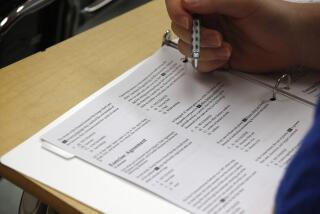Will UC schools drop their SAT scores requirement?

Half a century ago, the University of California helped catapult the SAT to a place of national prominence in the college admissions process when it began requiring all applicants to take the test and report their score.
Now the UC system, by its sheer size and influence as the nation’s premier public research university, is again poised to play an outsize role in the future of standardized testing in America as its leaders consider whether to drop both the SAT and ACT as an admissions requirement.
Although the standardized tests are predictive of college performance, particularly at selective universities, they are increasingly seen as an unfair admission barrier to students who don’t test well or don’t have the means to access or pay for pricey test preparation. Decades of research has shown that scores are strongly influenced by family income, parents’ education and race.
The looming question is how UC officials will move to address the clearly documented flaws of the test. If they choose to throw out the SAT and the ACT, another popular test, will they find a better replacement?
“Whatever we do will be a national precedent,” UC President Janet Napolitano said at a recent Board of Regents meeting. “And so … we want to get it right.”
The decision will be a “monster deal” because UC’s status is likely to heavily influence other universities and the testing industry itself, said Jay Rosner, an admissions test expert with the Princeton Review Foundation. Rosner said four-fifths of UC applicants take the SAT, the largest single university source of customers for the College Board, which owns the test. The six universities that receive the most applications in the nation are UC campuses in Los Angeles, San Diego, Irvine, Berkeley, Santa Barbara and Davis.
UC regents are not expected to make a decision until next year. But an extraordinary and unscripted exchange about 2 hours and 25 minutes into a recent meeting revealed the enormous stakes, deep passions and growing impatience surrounding the issue.
UC Academic Senate members, to whom the regents long ago delegated authority to set admissions criteria, launched a study this year on whether to continue requiring standardized testing. Applicants could still take the test and choose to self-report scores, but the UC system would join about 1,000 other universities nationwide as test-optional.
Board of Regents Chairman John A. Pérez startled meeting participants when he asked the UC general counsel whether regents were required to wait for the senate to finish its review before deciding the issue. Vice Chairwoman Cecilia Estolano followed his question by declaring that tests use a “clearly flawed methodology that has a discriminatory impact” and suggested a possible time limit on the faculty study.
“We don’t need any more studies,” she said.
Regent Eloy Ortiz Oakley said the issue was urgent, as “millions” of students would take the test and spend substantial sums on test preparation while regents delayed action. Pérez noted that even though nonprofits such as Khan Academy offer free online test preparation, only 3% of students at some underserved schools have regular access to the internet.
On the other side, Regent George Kieffer said he was concerned that if UC eliminated the SAT, the university system could be pressed in a few years to use another test to gauge student performance.
Napolitano cautioned the board to let the faculty finish its work without an “arbitrary timeline.” And Academic Senate Chairwoman Kum-Kum Bhavnani said any decision needed to be well-grounded in research to stand up to the reaction it will unleash.
Bhavnani said an 18-member faculty task force is expected to produce preliminary results by February.
One possible alternative: using Smarter Balanced, a test used in California and more than a dozen other states to assess how well K-12 students have mastered English and math skills required by standards known as Common Core.
Smarter Balanced tests predicted first-year college grades as well as SAT exams for UC and California State University students with less bias against disadvantaged students, said Michal Kurlaender, a UC Davis education professor who co-authored a March study on the question and made a presentation to a UC faculty group. Another advantage, she said, is that all students already take the Smarter Balanced test during school hours at state expense.
It is unclear, however, whether student performance on Smarter Balanced would change if it turned into a high-stakes college admission test, and such a sea change in UC testing policy would require much advance planning.
Other options include keeping standardized tests but controlling for the socioeconomic effects on scores. Zachary Bleemer, a research associate at UC Berkeley’s Center for Studies in Higher Education, said UC already effectively does that by admitting some less advantaged students with lower test scores than more advantaged peers.
UC San Diego, for instance, admitted African Americans, Mexican Americans and low-income students with average SAT scores about 300 points lower than Asian Americans, whites and high-income students for fall 2016. First-generation students were admitted with scores about 200 points lower than those whose parents attended college.
Although California’s Proposition 209 banned the use of race or ethnicity in admissions decisions, schools may evaluate test scores in the context of other factors, including an applicant’s family income and high school quality. UC considers 14 factors in its admissions decisions.
Kurlaender’s study and several others have found that high school GPA is the single strongest predictor of college success with the lowest negative effect on students who are low-income, underrepresented minorities or the first in their families to attend college.
But some educators are wary that going test-optional would spark even more grade inflation as high school teachers could be pressured to award more As.
For its part, the College Board said in a statement to The Times that its 2019 study of 223,000 students across 171 four-year colleges “confirms that SAT scores are strongly predictive of college performance” and that grades and test scores together provide more insight into a student’s potential than either measure alone.
ACT spokesman Ed Colby said its scores not only predict college success but also provide a common, standardized metric that allows colleges to compare students with widely different sources of information across a range of states and high schools. “No common metric increases the subjectivity of admissions decisions,” Colby said in a statement.
But the test-optional movement is accelerating, with 47 more schools joining in the last 12 months, double the number over last year, said Bob Schaeffer, public education director for FairTest, the National Center for Fair and Open Testing.
A major study last year found students who did not submit test scores were often admitted at lower rates and had modestly lower high school and cumulative college GPAs than those who submitted. But the graduation rates were comparable. The study also found that test-optional policies attracted more applicants of greater diversity, although Colby said other studies have shown otherwise.
At Pitzer College, a private liberal arts school in Claremont that became the first West Coast test-optional campus in 2003, about half of the applicants did not submit test scores. Their average first-year GPA of 3.4 is virtually the same as peers who submit scores, said Yvonne Berumen, vice president for admission and financial aid.
The University of Chicago, an elite private institution, decided to drop testing requirements to open access. Applications for fall 2019 increased 20% over last year, rising by 24% for first-generation students and 60% for rural students, said Peter Wilson, director of undergraduate admissions. He said the university considers high school transcripts, letters of recommendation, essays, extracurricular activities and such achievements as research projects, business proposals and creative arts performances. More than 85% of applicants still submit test scores, but those who don’t are evaluated on equal footing and the admission rate is identical.
Students, whether they scored high or low, tend to support test-optional college applications.
At George Washington Preparatory High School in South Los Angeles, several students interviewed this year said they wanted to take a test prep course but could not afford it and prepared using the Khan Academy website a few days before the SAT exam. They reported scores in the bottom 20th to 40th percentile.
Chelsea Salgado said she didn’t even know about practice tests, which high-scoring students say are an essential training tool. Ashlee Beard said she froze over math problems she knew she had learned to solve because “when I hear the word ‘test’ it freaks me out.”
“It’s a test that determines your future and it’s not fair,” said Abigail Laureano. “My mom cleans houses and can’t afford a tutor.”
In affluent South Pasadena, the test prep pressure is intense.
As a South Pasadena High School student, Elaine Yang took two different prep courses in 2017 and 2018, each of them eight weeks long, at a combined cost of about $2,000. They helped her raise her initial score by about 200 points to 1360, the 91st percentile, but she said she mostly just learned to build speed, stamina and testing strategies. She was admitted to Scripps College.
Lauren Kafkaloff, a South Pasadena High School graduate, spent about $100 on SAT and ACT guidebooks and took “a ton” of self-timed practice tests. She submitted the highest possible ACT test score of 36 and was admitted to the University of Pennsylvania this fall.
But she’s all for going test-optional and eventually getting rid of standardized tests entirely.
“It’s a waste of time for so many students who could be using their time more wisely doing something to change the world,” she said.
More to Read
Sign up for Essential California
The most important California stories and recommendations in your inbox every morning.
You may occasionally receive promotional content from the Los Angeles Times.











